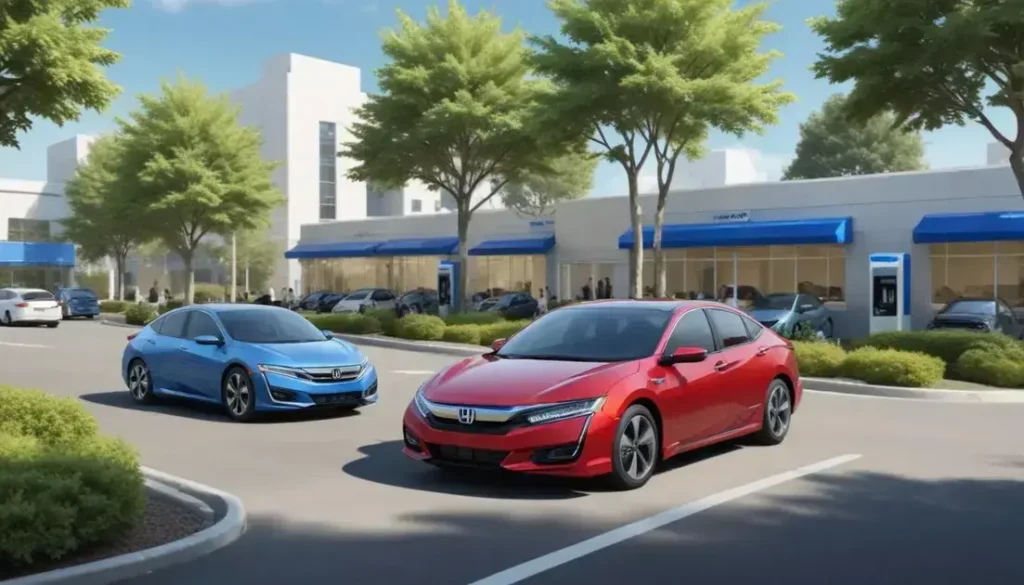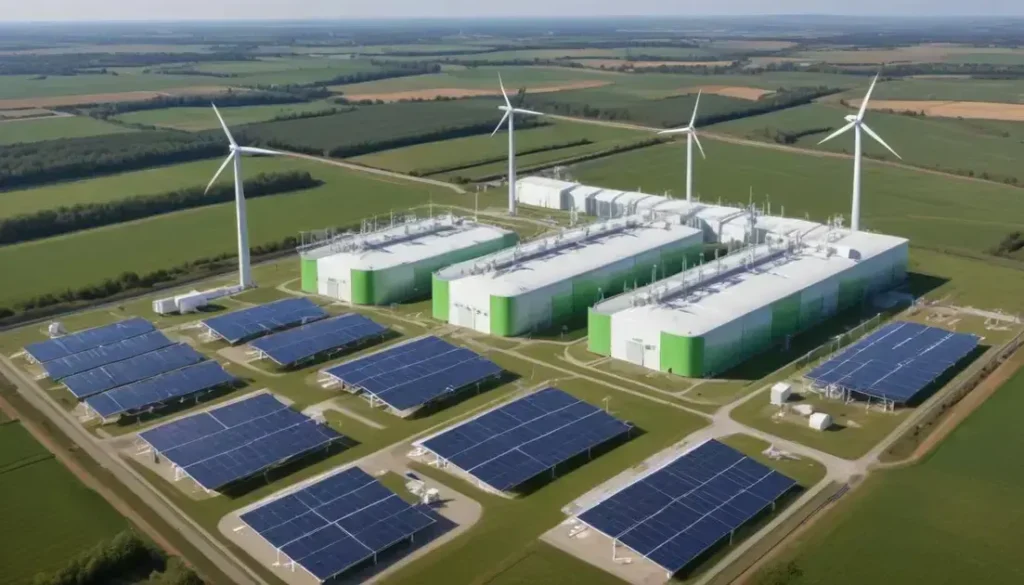Volvo’s commitment to net zero emissions by 2040 focuses on enhancing electric vehicle production, utilizing renewable energy, and adopting circular economy practices to reduce its carbon footprint throughout the vehicle lifecycle.
Have you ever thought about how carbon-neutral energy can reshape the automobile industry? By introducing the ES90, Volvo is not just innovating but also setting a global standard for sustainability. Let’s explore how this impacts you!
Introduction to Volvo’s sustainability efforts
Volvo has embraced a distinctive vision for sustainability, positioning itself as a leader in the automotive sector. With the ambition of becoming a wholly carbon-neutral company by 2040, Volvo aims to harmonize its business operations with ecological principles. This commitment is evident in the production of electric vehicles (EVs) and the integration of renewable energy sources across its facilities.
One of the cornerstones of Volvo’s sustainability efforts is the lifecycle approach to vehicle production. By assessing the environmental impact at every stage—from raw material sourcing to manufacturing, usage, and eventual recycling—Volvo promotes an eco-friendly model that minimizes waste. This is part of their **circular economy** strategy, which focuses on reusing materials and reducing emissions.
Volvo is also actively collaborating with various stakeholders, including governments and energy companies, to enhance EV infrastructure. These partnerships are crucial for expanding charging networks and making electric vehicles more accessible, ultimately encouraging consumers to make the switch from traditional vehicles.
To further cement its commitment to sustainability, Volvo has introduced innovative technologies aimed at improving fuel efficiency and decreasing the carbon footprint of its vehicles. As the automotive landscape evolves, Volvo stands as a testament to the potential of integrating sustainability at the heart of corporate strategies.
The role of the ES90 in carbon-neutral energy
The ES90 plays a pivotal role in Volvo’s quest for carbon-neutral energy. Engineered with cutting-edge technology, this electric vehicle is designed not just for performance but also for environmental efficiency. With zero tailpipe emissions, the ES90 sets a benchmark for sustainable driving.
Equipped with advanced battery technology, the ES90 maximizes energy efficiency, allowing for longer ranges on a single charge. This is crucial as it encourages more individuals to transition from combustion engines to electric alternatives, thereby reducing the overall carbon footprint.
The vehicle also integrates renewable energy sources for its manufacturing and charging processes, further enhancing its sustainability profile. By using green energy during production, Volvo ensures that the entire lifecycle of the ES90 aligns with its carbon-neutral ambitions.
Moreover, the ES90 is equipped with smart features that allow users to monitor their energy consumption and optimize driving habits, contributing to lower energy usage. This blend of technology and sustainability positions the ES90 as a leader in the electric vehicle market, appealing to environmentally conscious consumers.
Comparative carbon footprints of Volvo vehicles
Understanding the comparative carbon footprints of Volvo vehicles is essential for consumers and businesses alike. With the increasing push towards sustainability, Volvo has prioritized transparency in its environmental impact assessments. Each vehicle’s carbon footprint is calculated based on factors such as production emissions, fuel efficiency, and lifespan.
Electric models like the ES90 exhibit significantly lower carbon footprints compared to traditional internal combustion engine vehicles. This reduction is primarily due to zero tailpipe emissions during operation, coupled with the use of renewable energy in manufacturing processes.
Volvo’s commitment to sustainability is reflected in its lifecycle analysis. This approach allows the company to identify emission hotspots and implement strategies to minimize their impact. For instance, improvements in production efficiency, as well as sourcing materials from sustainable suppliers, contribute to reducing overall emissions.
When comparing different models, consumers can see that hybrid vehicles also offer a significant reduction in carbon footprints. They combine electric power with traditional fuels, thus lowering emissions while providing flexibility. As more consumers consider the ecological impact of their purchases, understanding these comparative insights becomes increasingly valuable.
Life Cycle Assessment (LCA) of electric models
The Life Cycle Assessment (LCA) of electric models is crucial for understanding their overall environmental impact. This comprehensive evaluation covers all stages of a vehicle’s life, from raw material extraction to end-of-life disposal. By examining each phase, companies like Volvo can identify opportunities for reducing emissions and resource consumption.
During the production phase, electric models typically require more energy compared to traditional vehicles due to battery manufacturing. However, the use of renewable energy sources during this process significantly mitigates their carbon footprint. This makes the transition to electric vehicles a sustainable option in the long run.
Throughout their operational life, electric vehicles produce zero tailpipe emissions, contributing to improved air quality, especially in urban areas. The efficiency of electric drivetrains also means that these models require less energy for the same distance traveled compared to conventional cars.
Finally, at the end of their life cycle, electric vehicle components, particularly batteries, must be recycled responsibly to minimize waste. Proper recycling processes can recover valuable materials, reducing the demand for new resources. Overall, a thorough LCA helps in promoting sustainable practices and guides manufacturers toward environmental accountability.
Impact of European energy on electricity prices
The impact of European energy policies on electricity prices is becoming increasingly significant, especially in the context of the transition towards renewable sources. European nations have been at the forefront of adopting green energy initiatives, aiming to reduce dependency on fossil fuels and lower carbon emissions. However, these changes can influence electricity costs across the continent and beyond.
As countries like Germany and France ramp up investment in wind and solar energy, fluctuations in energy supply can occur. When renewable generation is high, electricity prices often drop, benefiting consumers. Conversely, when reliance shifts back to traditional sources due to lower renewable output, prices may spike. This volatility challenges both households and businesses.
Moreover, the integration of European energy markets allows for the sharing of resources, which can stabilize prices. However, it also means that changes in energy policies in one country can ripple through to others, affecting overall costs. For instance, during periods of high demand or low renewable output, electricity prices can surge, prompting calls for more resilient energy infrastructures.
This interconnectedness highlights the importance of balancing investment in renewables with the need for affordable electricity. As European energy strategies evolve, their implications on electricity pricing will undoubtedly be a critical area of focus.
Volvo’s commitment to net zero emissions by 2040
Volvo’s commitment to net zero emissions by 2040 represents a bold step towards sustainable automobile production. This initiative aims to drastically reduce the carbon footprint of its vehicles throughout their entire lifecycle. By focusing on both manufacturing processes and the energy sources used in production, Volvo sets a clear example for the automotive industry.
To achieve net zero emissions, Volvo plans to enhance its electric vehicle (EV) lineup significantly. This involves investing heavily in innovative battery technologies and renewable energy solutions. The company is also exploring circular economy principles, which encourage recycling and reusing materials to minimize waste.
Additionally, Volvo is committed to transparency in reporting its progress. By setting measurable targets and timelines, the company aims to hold itself accountable while inspiring other manufacturers to follow suit. This initiative aligns with broader global efforts to combat climate change and foster sustainable practices across various industries.
As part of this commitment, Volvo also emphasizes the importance of collaboration with governments, suppliers, and consumers. By fostering partnerships, the company aspires to create an ecosystem that supports sustainable transportation and promotes awareness about environmental impacts.
Circular economy practices in car manufacturing
Circular economy practices in car manufacturing are transforming the automotive industry by prioritizing sustainability and resource efficiency. This approach aims to eliminate waste and make the most of available materials throughout the vehicle lifecycle. By adopting a circular model, manufacturers like Volvo are setting new standards for environmental responsibility.
One of the key aspects of a circular economy in car manufacturing involves the design phase. Vehicles are now engineered with recyclability in mind, ensuring that components can be reused or repurposed at the end of their lifecycle. This minimizes landfill waste and reduces the need for new raw materials.
Additionally, manufacturers are increasingly focusing on using sustainable materials. For instance, renewable resources, such as bioplastics and recycled metals, are sourced to create vehicle parts. This not only reduces the carbon footprint but also lessens the environmental impact associated with traditional materials.
Moreover, partnerships with recycling companies are an essential part of the process. By collaborating with experts in recycling, car manufacturers can ensure that end-of-life vehicles are dismantled efficiently and that valuable materials are recovered and reintegrated into the production cycle. Overall, the shift towards circular economy practices in car manufacturing reflects a commitment to sustainability and marks a significant advancement in the industry.
The future of EV infrastructure in India
The future of EV infrastructure in India holds great promise as the government and private sectors increasingly invest in a sustainable transportation system. A robust charging network is crucial for encouraging the adoption of electric vehicles (EVs) among consumers. As the demand for EVs rises, the expansion of charging stations across urban and rural areas becomes a priority.
Recent initiatives include collaboration between the government and private enterprises to facilitate the installation of fast charging stations. This initiative aims to make charging more accessible and convenient for users. Furthermore, integrating renewable energy sources into EV charging stations can significantly reduce the carbon footprint associated with electricity usage.
Another vital aspect of the EV infrastructure in India is the development of smart grid technology. This technology will enhance energy management, allowing for better distribution and consumption of energy resources. Smart grids can also facilitate the integration of emerging technologies, such as vehicle-to-grid capabilities, which will enable EVs to return power to the grid when needed.
Additionally, government policies, such as incentives for supporting infrastructure development and electric vehicle purchases, will play a critical role in creating an eco-friendly ecosystem. As these efforts gain momentum, the future of EV infrastructure in India looks bright, paving the way for a sustainable and environmentally friendly transport solution.
Conclusion and implications for Indian businesses
The transition towards electric vehicles (EVs) and sustainable practices presents significant opportunities for Indian businesses. With the Indian government’s commitment to reducing carbon emissions and enhancing green energy infrastructure, companies must adapt to stay competitive. Businesses that embrace ESG (Environmental, Social, and Governance) principles can strengthen their market position while contributing to global sustainability goals.
Firms in various sectors, including automotive, manufacturing, and technology, should consider investing in EV infrastructure and adopting sustainable practices. This not only improves operational efficiency but also appeals to environmentally conscious consumers. The increased demand for EVs suggests a growing market for suppliers of batteries, charging systems, and renewable energy sources.
Additionally, businesses that invest in research and development for sustainable technologies will likely gain a competitive edge. Collaborating with governmental and non-governmental organizations can facilitate access to funding and resources, supporting innovation in green technologies.
Moreover, adapting to these changes can enhance brand reputation, attracting both customers and talent who prioritize environmental responsibility. As the landscape of business continues to evolve, understanding the implications of sustainability will be crucial for long-term success in India’s dynamic market.
In Conclusion: The Path Forward for Indian Businesses
The shift towards sustainability and electric vehicles offers significant growth opportunities for Indian businesses. By adopting eco-friendly practices and investing in renewable energy infrastructure, companies can enhance their market position and attract a new wave of consumers.
It is essential for businesses to embrace change and innovate. Understanding the implications of sustainability is key for long-term success in today’s dynamic market. With government support and increasing public awareness, now is the time for businesses to align with these transformative trends.
Incorporating these strategies not only contributes to a better environment but also strengthens the brand’s reputation, making it appealing to customers who value sustainability. This movement towards green practices is not just a trend; it is the future of business.
Thus, by proactively adapting to this shift, Indian companies can not only thrive but also lead the way in creating a more sustainable world.
Frequently Asked Questions (FAQ)
What is the importance of sustainability for Indian businesses?
Sustainability is crucial for Indian businesses as it helps reduce environmental impact, appeal to eco-conscious consumers, and comply with government regulations. Adopting sustainable practices can enhance a company’s reputation and drive new growth opportunities.
How can businesses adapt to the shift towards electric vehicles (EVs)?
Businesses can adapt by investing in EV infrastructure, exploring partnerships for charging stations, and educating consumers about the benefits of EVs. Staying informed about government incentives for EV adoption can also be advantageous.
What steps can companies take to implement circular economy practices?
Companies can start by designing products that are easier to recycle, sourcing sustainable materials, and collaborating with recycling partners to minimize waste and environmental impact throughout the product lifecycle.
Why is it important to invest in renewable energy?
Investing in renewable energy reduces reliance on fossil fuels, decreases greenhouse gas emissions, and can lead to long-term cost savings. It also positions companies as leaders in sustainability, enhancing their market competitiveness.
How can collaboration with the government benefit businesses in this transition?
Collaboration with the government can provide access to funding, resources, and technical support. This partnership can help businesses effectively implement sustainable practices and infrastructure that align with national goals.
What role does consumer awareness play in the adoption of sustainable practices?
Consumer awareness drives demand for sustainable products and practices. Educating consumers about the benefits of sustainability can encourage them to support brands that prioritize environmental responsibility, further motivating businesses to adopt green strategies.


